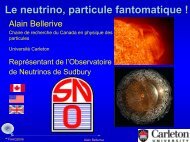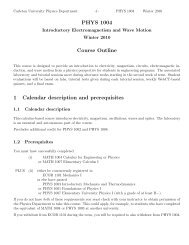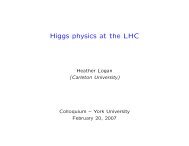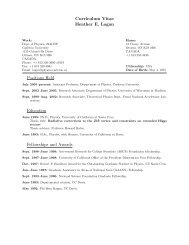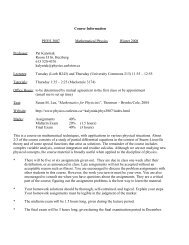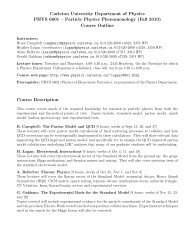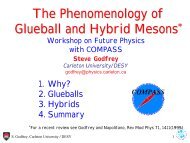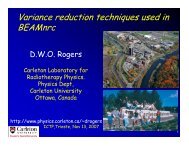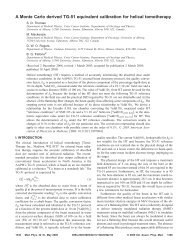How to write a lab report that will earn you a good mark and prevent ...
How to write a lab report that will earn you a good mark and prevent ...
How to write a lab report that will earn you a good mark and prevent ...
Create successful ePaper yourself
Turn your PDF publications into a flip-book with our unique Google optimized e-Paper software.
<strong>How</strong> <strong>to</strong> <strong>write</strong> a <strong>lab</strong> <strong>report</strong> <strong>that</strong> <strong>will</strong> <strong>earn</strong> <strong>you</strong> a <strong>good</strong> <strong>mark</strong> <strong>and</strong><br />
<strong>prevent</strong> <strong>you</strong>r TA from going insane<br />
Kate Whalen<br />
Oc<strong>to</strong>ber 7, 2009<br />
Many students are unsure of what constitutes a <strong>to</strong>p-quality <strong>lab</strong> <strong>report</strong>. With <strong>that</strong> in mind, I have<br />
prepared a list of tips <strong>and</strong> common mistakes broken down according <strong>to</strong> the sections of a typical <strong>lab</strong> <strong>report</strong>.<br />
First of all, DO NOT PLAGIARIZE. If <strong>you</strong> copy off <strong>you</strong>r partner, I can tell. If <strong>you</strong> copy off Wikipedia,<br />
I can tell. Bot<strong>to</strong>m line: don’t do it. You’ll get busted. If <strong>you</strong> borrow information from a book or online<br />
reference, <strong>you</strong> must cite the source. Grab any physics journal from the library or online (http://arxiv.org is<br />
a great source) <strong>and</strong> have a look at a few articles <strong>to</strong> see how <strong>to</strong> properly credit other authors.<br />
One of the most important fac<strong>to</strong>rs <strong>to</strong> remember is neatness. This counts a lot more than <strong>you</strong> might<br />
think. Hastily scribbled calculations, incomprehensible figures <strong>and</strong> disorganized or missing data tables make<br />
<strong>you</strong>r TA very annoyed. An annoyed TA is more likely <strong>to</strong> <strong>mark</strong> <strong>you</strong>r <strong>report</strong> harshly, whereas a neatly written<br />
<strong>report</strong> <strong>will</strong> put <strong>you</strong>r TA in a <strong>good</strong> mood, which often translates in<strong>to</strong> a better <strong>mark</strong>!<br />
Most importantly, LISTEN <strong>to</strong> <strong>you</strong>r TAs in the <strong>lab</strong> <strong>and</strong> READ THE MANUAL, including the appendices.<br />
These sources <strong>will</strong> provide all the information <strong>you</strong> need <strong>to</strong> do the experiment <strong>and</strong> <strong>write</strong> the <strong>report</strong>.<br />
1 Purpose<br />
• Don’t just copy it out of the manual, or <strong>you</strong> <strong>will</strong> get 0 for this section. Explain in a sentence or two<br />
the objective <strong>and</strong> how <strong>you</strong> <strong>will</strong> accomplish it. No need <strong>to</strong> repeat the entire procedure; just highlight<br />
the <strong>to</strong>ols, measurements, calculations, etc. <strong>that</strong> <strong>you</strong> used. For example: “Objective: To use a prism<br />
spectrometer <strong>and</strong> sodium <strong>and</strong> mercury light sources <strong>to</strong> determine the index of refraction of a prism,<br />
<strong>to</strong> identify the type of glass of which the prism is made, <strong>and</strong> <strong>to</strong> determine its resolving <strong>and</strong> dispersive<br />
powers.” It’s <strong>that</strong> simple!<br />
2 Apparatus<br />
• Include a diagram (done neatly by h<strong>and</strong>) <strong>and</strong> clearly <strong>lab</strong>el all important components. Figures should<br />
be large enough <strong>to</strong> clearly identify the components. If <strong>you</strong> are using a numbered sample (prism # 1,<br />
e.g.), make sure <strong>to</strong> identify it, since the TA might need <strong>to</strong> verify <strong>you</strong>r results.<br />
3 Theory (formal <strong>report</strong>s only)<br />
• Explain briefly the physical principles <strong>you</strong> are investigating.<br />
• Don’t just <strong>write</strong> down a bunch of equations! Explain them! What are the variables? What does the<br />
result mean? Why is each equation relevant <strong>to</strong> the experiment?<br />
1
4 Data & Calculations<br />
• Make sure <strong>you</strong>r TA initials <strong>you</strong>r rough data before <strong>you</strong> leave the <strong>lab</strong>. This is the only way I can be<br />
sure <strong>that</strong> <strong>you</strong>r data is <strong>you</strong>r own. If the signed, raw data isn’t in <strong>you</strong>r <strong>lab</strong> book, I’m going <strong>to</strong> be awfully<br />
suspicious. This does not bode well for <strong>you</strong>.<br />
• Every measurement <strong>and</strong> calculated result MUST have an uncertainty. Make sure <strong>to</strong> include the correct<br />
number of significant figures in the uncertainty. Refer <strong>to</strong> <strong>you</strong>r manuals if <strong>you</strong> are not sure how <strong>to</strong><br />
calculate this.<br />
• Data <strong>and</strong> calculations should appear in the <strong>report</strong> in the same order in which they were performed. If,<br />
for some reason, this is not possible, make a note referring <strong>to</strong> the appropriate page so the TA doesn’t<br />
have <strong>to</strong> go hunting for the missing work.<br />
• Calculations should be neatly organized, with the results clearly indicated (highlighting or drawing a<br />
box around the final result works very well). Take the time <strong>to</strong> recopy <strong>you</strong>r data tables <strong>and</strong> calculations<br />
neatly instead of just h<strong>and</strong>ing in <strong>you</strong>r rough notes by themselves. A sentence here <strong>and</strong> there <strong>to</strong> explain<br />
what <strong>you</strong>’re doing can be very helpful. The final results of <strong>you</strong>r calculations should be displayed neatly<br />
in a table. All tables must have titles. See the examples in <strong>you</strong>r manual.<br />
• Graphs should be big. BIG. Go on, use the entire page! All graphs must have titles, axis <strong>lab</strong>els, slopes<br />
(if applicable) <strong>and</strong> units. See the examples in <strong>you</strong>r manual.<br />
5 Discussion<br />
• DO NOT say things like “This was an interesting <strong>lab</strong> <strong>and</strong> I l<strong>earn</strong>ed a lot about...” or “This experiment<br />
was a success.” This is guaranteed <strong>to</strong> make <strong>you</strong>r TA’s head explode.<br />
• Instead, discuss the physical significance of <strong>you</strong>r results. Do they make sense? (Hint: statistical analysis<br />
can be useful here. See <strong>you</strong>r manual.) Say, for example, <strong>you</strong>r prism has a ∆λ value of 0.28 nm. What<br />
does this mean? <strong>How</strong> does it influence <strong>you</strong>r other results?<br />
• Try <strong>to</strong> determine which uncertainties or sources of error had the greatest impact on <strong>you</strong>r results. Hint:<br />
It’s not human error, nor is it the fact <strong>that</strong> <strong>you</strong> believe <strong>you</strong>r partner <strong>to</strong> be a moron. These are two<br />
more “<strong>lab</strong> <strong>report</strong> greatest hits” <strong>that</strong> <strong>will</strong> make the TA’s head explode.<br />
• Is there any way <strong>to</strong> reduce the uncertainty on <strong>you</strong>r results? Can <strong>you</strong> think of a better experimental<br />
setup, measuring technique or analytical method <strong>that</strong> would improve the <strong>lab</strong>? (Be reasonable - we<br />
don’t have access <strong>to</strong> an a<strong>to</strong>mic clock, for example, <strong>and</strong> even if we did, <strong>you</strong> probably wouldn’t be allowed<br />
<strong>to</strong> <strong>to</strong>uch it.)<br />
6 Conclusion<br />
• In a few lines, sum up the results of the experiment. Did <strong>you</strong> confirm some hypothesis or law?<br />
7 A few last words<br />
What’s the most important point <strong>to</strong> take away from all this (other than the fact <strong>that</strong> <strong>you</strong>r TA has far <strong>to</strong>o<br />
much <strong>to</strong> say)? Be thorough in everything <strong>that</strong> <strong>you</strong> do in the <strong>lab</strong>. Physics is all about underst<strong>and</strong>ing how the<br />
universe works, down <strong>to</strong> the finest details. If <strong>you</strong> ignore the details by being careless in <strong>you</strong>r measurements<br />
or <strong>you</strong>r analysis, <strong>you</strong> cannot expect <strong>to</strong> obtain <strong>good</strong> results. <strong>How</strong>ever, if <strong>you</strong> take the time <strong>to</strong> fine-tune<br />
<strong>you</strong>r experimental technique <strong>and</strong> perform the necessary calculations <strong>and</strong> analysis, <strong>you</strong> <strong>will</strong> find <strong>that</strong> <strong>you</strong> <strong>will</strong><br />
receive better <strong>mark</strong>s on <strong>you</strong>r <strong>lab</strong> <strong>report</strong>s - <strong>and</strong> <strong>you</strong> might just l<strong>earn</strong> something along the way.<br />
2




